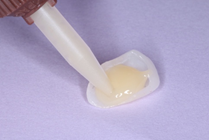It would appear that Tokuyama Dental has again come up with another material that combines multiple steps into one single step. EsteCem II is a dual cure resin cement with some interesting properties, simplifying the cementation of all types of restorative materials. Included with the kit is Tokuyama Universal Bond, which is used as a pretreatment to enhance the bonding to tooth structure and substrate material. In terms of its chemistry, Tokuyama Universal Bond wears many hats, and has the ability to bond to all materials. As an example, it will etch, prime and bond to tooth structure in one step and will also act as a silane for glass materials such as ceramics and porcelain.
After using it for nearly a year, what stood out to me clinically was the ability of EsteCem II to adhere to all substrates. That includes zirconia, all types of precious, semi, and non-precious metals, ceramics, and resin-based materials, among others. How it does make life easier when it comes to cementation of indirect restorations can be demonstrated with the following cases, each requiring its own preparation style and unique material.
CASE #1
Once the tooth was anesthetized, the provisional crown was removed, the prep cleaned and Tokuyama Universal Bond applied to the damp dentin and the intaglio surface of the zirconia crown. After drying, EsteCem II resin cement was injected into the crown and the fixed restorative seated on the prep. After light curing for three seconds, excess cement was removed easily from around the margins and interproximal areas. The crown was then reevaluated for any occlusal discrepancies, and polished using Jazz polishers (SS White).
Fig.1 Fig.2

Fig.3 Fig.4


CASE #2
I selected the second case to show the cementation of a high particle filled resin onlay. Following local anesthesia, the provisional was removed and the prep cleaned. The site was prepared for cementation using a Reel Matrix (Garrison) to provide excellent isolation, and preventing the cement from leaking outside the preparation into the interproximal areas. Tokuyama Universal Bond was then applied to enamel and damp dentin, as well as the intaglio surface of the onlay. After drying both the prep and onlay, EsteCem II (Brown Shade) was injected directly into the cavity preparation and the onlay seated to place.
Fig.1 Fig.2




EsteCem II excess was removed after an initial 3 second tack cure. The beauty of using a matrix is that allows the cement to be set for several minutes, providing a firm set in the proximal sites.
After matrix removal, the occlusion was adjusted and the restoration polished. Notice that selection of the brown EsteCem II shade allowed for perfect blending of the onlay, especially at the margins.
CASE #3
EsteCem II (Tokuyama Dental):
This case required an increase in incisal height of both lower cuspids in order to regain canine protected occlusion. Following local anesthesia, the provisional veneers were removed, the prep cleaned, and Tokuyama Universal Bond applied to both the veneer and the tooth surface. Because veneers are often made to fit an already existing area of contact, shims, strips and other blockout interproximal strips should not be used. They often occupy the space needed for cement to properly seal the margins.
EsteCem II Universal shade was selected and injected into the veneer. It is critical that an adequate amount of cement is dispensed into the intaglio of the veneer, making sure to fill the veneer with enough resin cement thus avoiding air pockets, compromised esthetics and potential fracturing. The restoration was seated in the place and the cement cured, the completed veneer immediately following cementation, adjustment and polishing.
Fig.1 Fig.2


Fig.3 Fig.4



